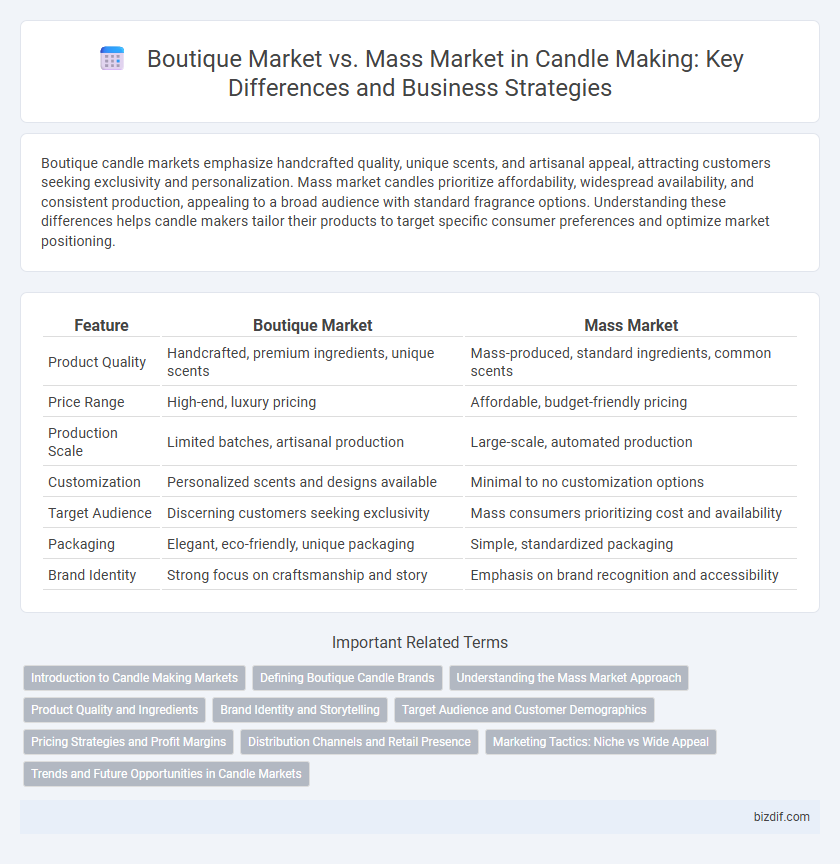Boutique candle markets emphasize handcrafted quality, unique scents, and artisanal appeal, attracting customers seeking exclusivity and personalization. Mass market candles prioritize affordability, widespread availability, and consistent production, appealing to a broad audience with standard fragrance options. Understanding these differences helps candle makers tailor their products to target specific consumer preferences and optimize market positioning.
Table of Comparison
| Feature | Boutique Market | Mass Market |
|---|---|---|
| Product Quality | Handcrafted, premium ingredients, unique scents | Mass-produced, standard ingredients, common scents |
| Price Range | High-end, luxury pricing | Affordable, budget-friendly pricing |
| Production Scale | Limited batches, artisanal production | Large-scale, automated production |
| Customization | Personalized scents and designs available | Minimal to no customization options |
| Target Audience | Discerning customers seeking exclusivity | Mass consumers prioritizing cost and availability |
| Packaging | Elegant, eco-friendly, unique packaging | Simple, standardized packaging |
| Brand Identity | Strong focus on craftsmanship and story | Emphasis on brand recognition and accessibility |
Introduction to Candle Making Markets
Boutique candle making markets cater to niche customers seeking artisanal, handcrafted products with unique scents and premium ingredients, often emphasizing sustainability and personalization. Mass market candle production targets broad consumer bases through large-scale manufacturing and cost-efficient processes, prioritizing affordability and widespread availability in retail chains. Understanding the distinct demands and pricing strategies of each market segment is crucial for candle makers to position their products effectively and maximize profitability.
Defining Boutique Candle Brands
Boutique candle brands specialize in handcrafted, artisanal products emphasizing unique scents, high-quality natural ingredients, and limited production runs that appeal to niche markets. These brands prioritize customization, aesthetic design, and sustainable sourcing to differentiate themselves from mass market competitors. Boutique candles often command premium pricing due to their exclusivity, attention to detail, and strong emphasis on brand storytelling.
Understanding the Mass Market Approach
The mass market approach in candle making emphasizes large-scale production to meet widespread consumer demand, prioritizing affordability and accessibility over unique or artisanal qualities. Manufacturers optimize cost efficiency through standardized designs, predictable scents, and bulk packaging to attract budget-conscious buyers in mainstream retail environments. This strategy contrasts sharply with the boutique market, which focuses on handcrafted, personalized candles targeting niche customers seeking exclusivity and premium experiences.
Product Quality and Ingredients
Boutique market candles prioritize premium, natural ingredients such as soy wax, essential oils, and lead-free cotton wicks, ensuring higher quality and artisanal craftsmanship. Mass market candles often rely on cheaper paraffin wax and synthetic fragrances, which can compromise scent authenticity and burn safety. Consumers seeking durability and eco-friendliness typically prefer boutique candles for their superior ingredient transparency and production standards.
Brand Identity and Storytelling
Boutique candle brands thrive on distinctive brand identity and compelling storytelling that emphasize artisanal craftsmanship, unique fragrances, and eco-friendly ingredients. Mass market candles often prioritize affordability and consistency, resulting in less personalized branding and generic scent profiles. Strong storytelling in boutique markets enhances customer loyalty by connecting emotionally, while mass market strategies focus on wide-reaching appeal and volume sales.
Target Audience and Customer Demographics
Boutique candle markets primarily target affluent, design-conscious consumers seeking unique, artisanal products with natural ingredients and custom scents, often aged 25-45 with disposable income. Mass market candles appeal to a broader, price-sensitive demographic, including families and middle-income households looking for affordable, readily available options with standard fragrances. The boutique segment emphasizes exclusivity and craftsmanship, while the mass market prioritizes convenience and volume sales across diverse retail channels.
Pricing Strategies and Profit Margins
Boutique candle makers often adopt premium pricing strategies, leveraging handcrafted quality and unique scents to command higher profit margins per unit. In contrast, mass-market producers focus on cost efficiency and economies of scale, enabling competitive pricing but resulting in lower profit margins. Strategic positioning in the boutique segment allows for differentiation through exclusivity, while mass-market players prioritize volume sales to drive profitability.
Distribution Channels and Retail Presence
Boutique candle makers often utilize specialized distribution channels such as artisan shops, local boutiques, and online marketplaces tailored to niche audiences, enhancing brand exclusivity and customer experience. Mass market candles are broadly distributed through large retail chains, supermarkets, and big-box stores, prioritizing high volume sales and widespread availability. This distribution strategy creates distinct retail presences, with boutique candles emphasizing curated, high-end environments and mass market candles focusing on convenience and accessibility across diverse retail locations.
Marketing Tactics: Niche vs Wide Appeal
Boutique candle makers leverage targeted marketing tactics emphasizing uniqueness, artisanal quality, and storytelling to attract niche audiences willing to pay premium prices. Mass market brands prioritize wide appeal through extensive distribution, competitive pricing, and mass media advertising to reach a broad consumer base. Effective segmentation and messaging tailored to either exclusivity or accessibility define success in boutique versus mass market candle sales.
Trends and Future Opportunities in Candle Markets
The boutique candle market emphasizes artisanal craftsmanship, unique scents, and eco-friendly materials, catering to consumers seeking personalized and luxury experiences. In contrast, the mass market focuses on affordability, wide distribution, and mainstream scents, appealing to a broader audience but facing saturation. Emerging trends in sustainable sourcing, clean-burning waxes like soy and beeswax, and smart candle technology offer significant growth opportunities for both segments.
Boutique Market vs Mass Market Infographic

 bizdif.com
bizdif.com